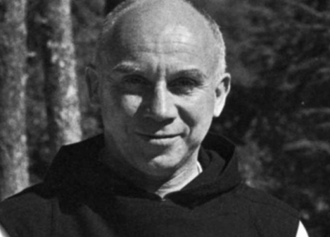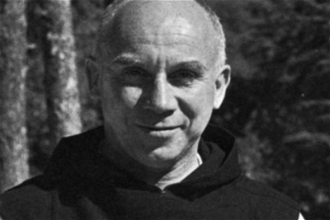Conference recalls Thomas Merton in Alaska

Source: CatholicAnchor.org
More than 400 people, representing some two dozen Christian denominations, traveled from five continents to gather in Anchorage, Alaska, for the 'Thomas Merton in Alaska' conference that marked the 50th anniversary of the famous monk's journey to the north.
The diverse crowd included two Buddhist monks who journeyed from Thailand for the occasion.
The two-day conference kicked off on September 28 with many attendees traveling to St John's Orthodox Cathedral in Eagle River, the site where Merton spoke to Catholic nuns 50 years earlier, back when the land was owned by the Catholic Church.
Later that evening, conference-goers packed into St Elizabeth Ann Seton Church for the opening presentations.
Anchorage Archbishop Paul Etienne welcomed the large crowd and recalled how his encounter with Merton's work inspired him to seriously consider that God might be calling him to the priesthood.
As a young man, the future archbishop had his sights set on getting married and starting a career. The priesthood was not part of the plan.
This began to change, however, when as a college student he visited Gethsemani Abbey in Bardstown, Kentucky. This was where Merton lived as a Trappist monk from 1941 until his death in 1968.
During that Holy Week visit of 1983, Etienne's heart began to change.
"That's when I really began to give into the call of the priesthood," he recalled. "At that time I was introduced to Thomas Merton's writings, 'Seven Storey Mountain,' and that made a lot of sense to me because I was very confused in those days."
Like many who have read Merton's celebrated autobiography, Archbishop Etienne was moved to seek God's will with a greater sense of urgency.
"The writing of his that I read was what I needed at that stage of my journey and at that stage of my discernment," he said.
Dr Paul Pearson delivered the first keynote address and traced the startling journey of the former hot-headed atheist who became America's most celebrated monk.
As director of The Thomas Merton Center at Bellarmine University, Pearson brought Merton's biographical highlights to life. At several points he played audio clips of Merton speaking to novices under his charge at Gethsemani Abbey.
With Merton's own voice resounding through the Anchorage parish, Pearson displayed illustrations from the monk's archives - including Merton's photos, letters and political cartoons from his college days. The effect was a vividly recounted presentation of Merton's early life and college career, his discernment to the priesthood, and his writings and influence on American culture.
Through a series of books on prayer and contemplation, Merton introduced monastic practices to 20th century people who were longing for meaning in life, Pearson argued.
Along the way, the man who fled the world for monastic silence wound up becoming a "world embracing monk" at the end of his short life, Pearson said.
Attempting to balance a contemplative prayer life with social advocacy, Merton's writings began to address the tragic cost of war, the spiritual and social importance of addressing racial inequality, the need to care for creation. Pearson said Merton was a strong believer in nonviolent action, and ended up befriending Martin Luther King Jr.
Merton's concern over the appropriate use of technology and the growing distractions in popular culture are issues that have only grown more intense over the last half-century, Pearson said.
"Merton's questions still get at the heart of the matter," he said, citing the monk's concern over whether there was still a place for contemplation in the modern world.
Pearson said Merton opened up a new level of dialogue with those from other Christian denominations. This dialogue expanded to Merton's interaction with people from all the major world religions and those with no faith at all.
Merton wanted to find what was in common between his Catholic faith and those of other denominations and religions, Pearson said. "He wanted to affirm all that he could in them," without compromising his own Catholic tradition.
The second day of the conference began with Merton scholar Ron Dart, a professor at the University of British Columbia.
Dart highlighted the ecumenical friendships that Merton maintained.
"Merton transcended the political ethos of his time," he said, noting that the monk was a "bridge builder between Orthodoxy and Roman Catholicism."
"There's a history here of people not talking and how do we overcome that," Dart said, and this is what Merton delved into through his varied friendships.
"He held a high priority for friendship," Dart said of the monk who was interested in anyone who was "trying to live the contemplative life in the modern world." These friendships crossed cultures, political backgrounds and ecclesial backgrounds. This was part of Merton's emphasis on "community rather than the collective," more in "what it means to be a person" rather than an individual, Dart observed.
He noted that Merton was aware of the threats to authentic human happiness and was concerned about a "culture that was addicted to doing, doing, going," with no time or place to listen to God in silence.
Be that as it may, Merton was not content to merely retreat into a life of prayer.
Picking up on this theme was Gordon Oyer, an award-winning author who researches and writes about the life and thought of Merton. He spoke of the monk's struggle to balance his contemplative monastic life with his concern over social injustices of his day. Oyer noted that, while Merton was sometimes criticized for his social advocacy, he boldly addressed the turbulence of his day.
The social movements of the 1960s; the struggle for civil rights, ecological concerns, the tragedy of war and the challenges of technology to serve humanity (and not vice versa) were of great concern for Merton, Oyer observed.
"I can't imagine what he would think today," Oyer said.
In her presentation titled "From the Inner Frontier to the Last Frontier: Thomas Merton's 1968 Alaska Journey," author Kathleen Tarr delighted listeners with reflections from her recently published memoir on Merton's Alaska visit, "We Are All Poets Here."
She spoke of little-known encounters between the famous monk and the Alaskans he met during his 1968 trip north, some of whom were in attendance.
As Tarr noted, "Merton, the ceaseless explorer, the comeback monk, did not come [to Alaska] as a religious celebrity." Nor was he received as such.
Rather, Merton came seeking spiritual renewal and with the aim to inspire faith in the Alaska Catholics with whom he met.
The conference concluded with a man who studied under Merton in the last decade of the monk's life. Brother Paul Quenon was only a novice when he first encountered Merton at Gethsemani Abbey.
He spoke of Father Louis (Merton's name in the monastery) as a man of unquenchable passion for God.
Addressing the much-rumored plan of Merton to live out his last days as a hermit in Alaska, Brother Quenon put it in perspective.
"There is much that might have been if Father Louis had lived," he said, referencing Merton's sudden death following an accident in Thailand when he was just 53 years old.
"He never became a hermit in Alaska," Brother Quenon noted. "Frankly I'm not sure Father Louis could ever have lived as a hermit, could have ever settled down."
"He was intrinsically a homeless soul" with a burning desire for the hermetical life, Brother Quenon recalled. "This desire inspired men and women everywhere to seek the inner life of solitude."
Brother Quenon said Merton helped transform Gethsemani Abbey's understanding of itself. Thanks in part to Merton, the Trappist monks there now see themselves as a contemplative community more than as a rigorous religious order, although life is still quite ordered and strict.
By his example Merton taught Brother Quenon to redeem the simple acts of life, he said.
"Life lived in God is sufficient. To do the chores and greet the smiles of others is enough," he said. "Life lived in God serves "no other purpose," but is lived for its own sake.
He added: "God is sufficient. That is the root of peace. We have that peace when God is all we seek."
Editor's note: Annette Alleva contributed to this article.
Source: www.CatholicAnchor.org


















